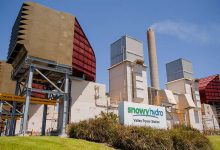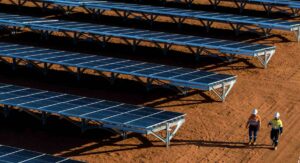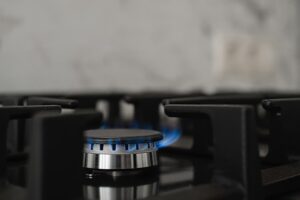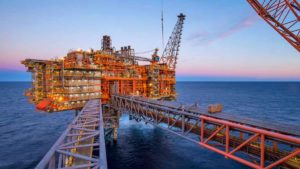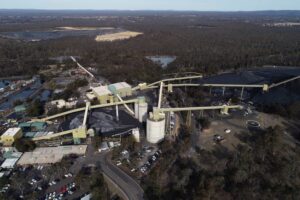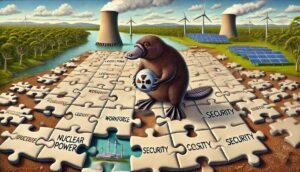The federal government owned Snowy Hydro has finally admitted that the contractors to its multi-billion dollar Snowy 2.0 pumped hydro project have lodged claims for cost over-runs as a result of the impact of Covid, bushfires and other factors.
In its annual report tabled in parliament this week, Snowy Hydro insists that the claims from Snowy 2.0 contractors We Build and Clough – are too early to assess. But its senior executives still pocketed millions in bonus payments, including for meeting cost and performance targets on the controversial project.
Snowy Hydro has largely stayed silent on the claims made by Clough owner Murray & Roberts on significant cost over-runs, and from federal climate minister Chris Bowen that lengthy delays that could run to 18 months or more. It has not even confirmed a new project timetable with the market operator.
Its annual report paints a rosy picture of the status of the project, even though South Africa’s Murray & Roberts is clearly struggling, admitting it has no working capital facility for the division managing the contract, has experienced a plunge in its share price and amid rumours and reports that Clough has been put up for sale.
“As with any major project globally, Snowy 2.0’s EPC Contractor, the Future Generation Joint Venture (Future Generation, which includes the two contractors), has been significantly impacted by external events, comprising bushfires, the COVID-19 pandemic and supply chain challenges,” the Snowy Hydro annual report says.
“Given the complexity and scale of Snowy 2.0, Snowy Hydro and Future Generation are in ongoing discussions regarding the above impacts.
“It is not possible to determine what entitlement Future Generation may have as all current claims are at an early stage and not advanced beyond the submission of an interim (as opposed to a final) claims document. Claims resolution will follow the appropriate contractual and/or judicial process.”
Still, any doubts about the fate of the Snowy 2.0 contracts were extinguished – at least for the purposes of the last financial year – by the company’s remuneration committee.
It approved $4.5 million in bonuses to the company’s nine most senior executives, including CEO Paul Broad, with Snowy 2.0 part of that assessment.
Despite Bowen, representing the sole shareholder saying in early June, before the end of the financial year, that the Snowy 2.0 project was badly delayed, the remuneration report states: “Overall Snowy 2.0 project delivered progress in line with projections with solid outcomes on Quality and Earned Value.”
Broad, who resigned suddenly in August as a result of tensions with federal climate minister Chris Bowen – which Broad blamed at least partly on the government’s push for hydrogen at the Kurri Kurri gas project – received $2.7 million, including $1.4 million in short term bonuses. There was no word on his termination or exit payments.
Overall, Snowy Hydro reports a slight fall in underlying earnings, to $189 million from $271 million a year earlier, which it blamed on the cost of “keeping the lights on” in the recent energy crisis, when it was posted record generation from its hydro assets, as well as gas and diesel.
“Snowy Hydro played a pivotal role in keeping the system secure and keeping the lights on, often covering for baseload shortages in the NEM and breaking generation records along the way,” it said.
“We did so even though generating at this heightened level was financially costly for the business; it was essential for avoiding blackouts.
“This extraordinary level of directed generation resulted in material adverse impacts for the business, with the Generation division reporting a substantial loss in June, whilst using a major portion of our Required Annual Release under the Snowy Water Licence.”
It warns of a complicated and potentially difficult year ahead, partly because of the risk of further electricity supply shortages “occurring at no or very short notice.”
It also says its water resource availability for FY2023 has been significantly reduced, partly because of the heavy use in the last market crisis, and also because it is capped by minimum and maximum water flow requirements for environmental and agricultural purposes.
It also warned its dual-fuel gas generators were required to generate significantly more than usual and for long periods on diesel.
“This caused an increase in plant reliability issues compared to the rest of 2022. Given that the electricity and gas market issues are expected to persist for some time, operating strategies are being reviewed to ensure that the operational plant teams are suitably prepared.”
Snowy Hydro’s dividend was lifted from last year’s $123 million, but its payment of $164 million – including a “special dividend of $25 million – falls well short of the level of at least $250 million promised by Broad in an appearance before Senate Estimates just three years earlier.
Snowy Hydro had promised to deliver $1.1 billion in dividends over four years, but has only paid out $742 million, according to Ted Woodley, a former head of EnergyAustralia and a critic of the Snowy 2.0 project.
Woodley says that is a poor return on investment for the federal government which put a value of $7.8 billion on Snowy Hydro when it bought all the outstanding shares in the company.

